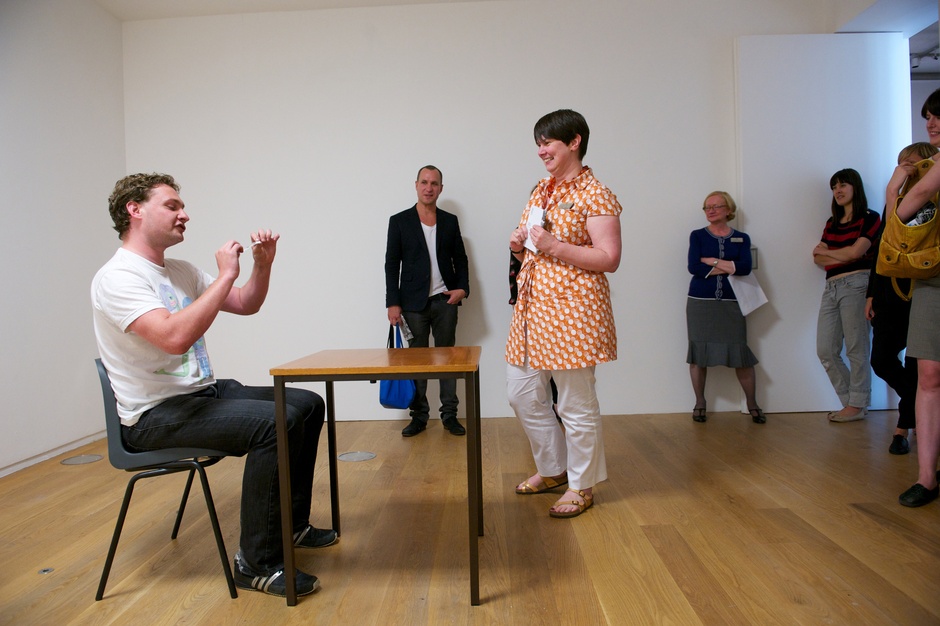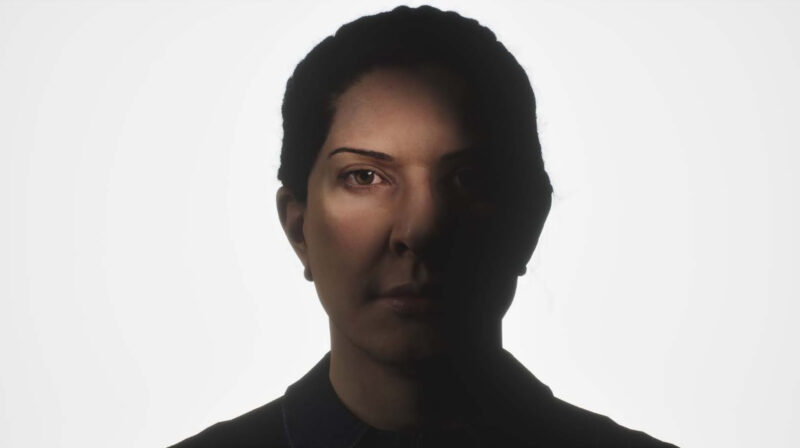
Image: John Baldessari Review by Jareh Das
9th -17th July 2011 – 11 Rooms Manchester Arts Gallery Review by Jareh Das
This year’s visual art presentation at Manchester Art Gallery, part of Manchester International Festival has one prevailing theme, ‘The artist is absent’. Previous editions emphasised on the artist being present, with 2010 infamously seeing Marina Abramovic presents include the artist and other participating artists take part in various durational performances.
Curated by Hans Ulrich Obrist and Klaus Biesenbach, eleven artists of all ages are brought together to present performance in eleven rooms, forming a set of instruction from the artists. Having had the privilege of seeing the whole exhibition come together, it was interesting to hear Obrist’s anecdote of 11 rooms and liken it to living sculptures. This for me alludes to singing and living sculptures by Brit-duo Gilbert and George in the seventies.

Image:Roman Ondak Swap Review by Jareh Das
11 Rooms starts with Swap, 2011 by Roman Ond·k’s. As its title implies, it presents a performer in a room with an object available for swapping. A chain of exchange is created throughout the exhibition, which sees the last performer take away the object away with them when this process ends on Sunday.
Next up is a re-staging of Joan Jonas’ seminal performance Mirror Check, first performed by the artist in 1970. This piece consists of a naked performer looking at her body’s reflection in a circular mirror. There are restrictions on what the performer can see, which is markedly different from what the audience sees. This piece questions the idea of what the eye sees and what is concealed. It sets up a paradigm between what we see and how we are seen, whilst playing on ideas of reality and fantasy.
Spanish artist Santiago Sierra’s practice focusing on situations of exploitation, takes a more political approach here as Veterans of wars Northern Ireland, Afghanistan and Iraq facing the corner, 2011 sees a war veteran stand in the corner, not responding to visitors who enter the room. This piece is particularly powerful as it makes the viewer uncomfortable, why can’t we see the veteran’s face? What goes on as it were behind the closed doors of war? It also highlights the facelessness of conflict i.e. the soldiers we never see or hear about during and after conflicts.
Tino Sehgal on the other hand, presents works that exist through an engagement specific to a particular time and place. It exists solely in memory as none of his situations are recorded or documented. Ann Lee, 2011 is in keeping with his ongoing exploration of opposing traditional artwork and museum context. Here we have a scenario were a young girl, acting as an animatronic imbued in art world lingo, starts a conversation about her existence and commodified nature, also questioning and acknowledging her audience’s presence. The work for me is successful as it questions the foundations of commodifying objects. Its material value can be bought by virtue of being repeatable, hence transcending time, making Seghal’s practice timeless.
Other rooms include a proposal for a dead cadaver presented in a detailed textual display by John Baldesseri, although the actual body is absent. This can be seen as an unrealised or rather soon to be realised project. Simon Fujiwara explores histrionic personality disorder manifested by narration by actors named Simon, from a book on the history of various Saint Simons. Xu Zhen’s performers suspended mid fall In Just A Blink of an Eye, 2005, an impression of time standing still.
Men=Flesh/Women=flesh – FLAT, 1997/2010, by Brazilian artist Laura Lima, challenges the notion of space as she has the ceiling of her room at a height of 45cm. The performer lies close to a single light bulb on the floor and has some form of a disability. To observe the piece, visitors have to crouch down often mimicking the position of the performer, lying down still. Lima employs the body as a medium and feels all humans are equal when reduced to flesh, demonstrated in this piece as once, positioned in the space it is unclear if the performer is disabled or not.
Also challenging physical space, artist duo Allora and Calzadilla, have directed a group of performers to align themselves in a continuous but shifting line arrangement in Revolving Door, 2011. It forces you to think and act quickly as well as trying to premeditate which direction the human line will take next. It is humorous and great fun. Humour aside, the piece also draws to mind line formations in protests, conflicts, marches and other socio-political forms of resistance.
Lucy Raven pianola piece, What Manchester Does Today The Rest of the World Does Tomorrow, 2011, the piano key are controlled by holes punched into a paper roll. This mechanism is similar to modern day computing principles, removing the person from the act of playing. Raven’s concern with shifts in technology is interesting in today’s highly digitised context. She also comments on this by programming the Pianola to play a transcription of electronic track, Dance Yrself Clean by LCD Soundsystem. It reverts the now to the past, looking at the instrument’s history, evolution and inherent decline due to the continual advancement of technology.
The exhibition concludes with Luminosity, 2011 by Marina Abramovic. A naked performer sits on a suspended bicycle seat, with a white luminous square background, as if floating in space. The piece shows vulnerability in terms of the performers pose, but it also highlights something that transcends physicality through exposing the vulnerable. The performer at times locks in a bewitching gaze with the audience making the viewer aware of one’s own vulnerability.
11 Rooms presents varying contexts of ‘live’ experiences. It questions the role of the artist, curator, performer and visitor alike as it presents situations where one has to consider their role within time and space. It also highlights how time and space can be constructed and manipulated, especially when dealing with history and the construction of knowledge.

Image:Santiago Sierra Veterans of the wars of Northern Ireland Afghanistan and Iraq








